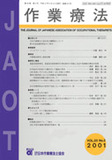Japanese
English
- 販売していません
- Abstract 文献概要
- 1ページ目 Look Inside
- 参考文献 Reference
- サイト内被引用 Cited by
要旨:脳性麻痺児は,フィードバックを含む刺激を取り込み,脳内で処理する感覚統合に大きな問題を持つ.本研究は,前庭刺激を中心とした感覚統合療法を2症例の痙直型脳性麻痺児に実施したことが,視知覚技能に好ましい影響を及ぼしたかどうかを検討するために実施された.
方法:評価後,初期に3ヵ月間感覚統合療法を実施し,次の3ヵ月間は感覚統合評価期間とし感覚統合療法は実施せず,後期に再び3ヵ月間感覚統合療法を実施した.独立変数を感覚統合療法とし,従属変数を視知覚技能検査,フロスティッグ視知覚検査,日本版ミラー幼児発達スクリーニング検査,ウェクスラー幼児知能診断検査の各得点とし,それらの変化を検討した.
結果:6ヵ月間の感覚統合療法を実施することで,2症例とも皮質下レベルの感覚統合の改善,視知覚技能の改善が認められ,脳性麻痺児に対する感覚統合の効果が認められた.
Children with cerebral palsy have serious problems of sensory integration. In this study, in order to examine the improvement of visual perceptual skills through applying sensory integrative therapy, we provided mainly vestibular stimulations for two children with spastic type cerebral palsy. Method: We applied sensory integration techniques for three months, followed by three months of suspension of treatment, and then another three months of therapy. The independent variable is the sensory integrative therapy, and the dependent variables are represented by scores on the following tests: Test of Visual Perceptual Skills (TVPS), Developmental Test of Visual Perception (DTVP), Japanese Version of Miller Assesment for Preschoolers (JMAP), and Wechsler Preschool and Primary Scale of Intelligence (WPPSI). Results: The scores of the visual perception tests for both children with cerebral palsy improved after applying sensory integrative therapy for six months.

Copyright © 2001, Japanese Association of Occupational Therapists. All rights reserved.


